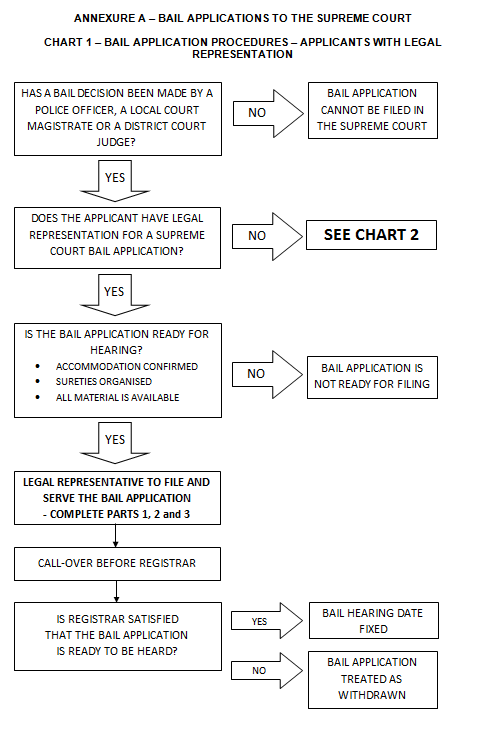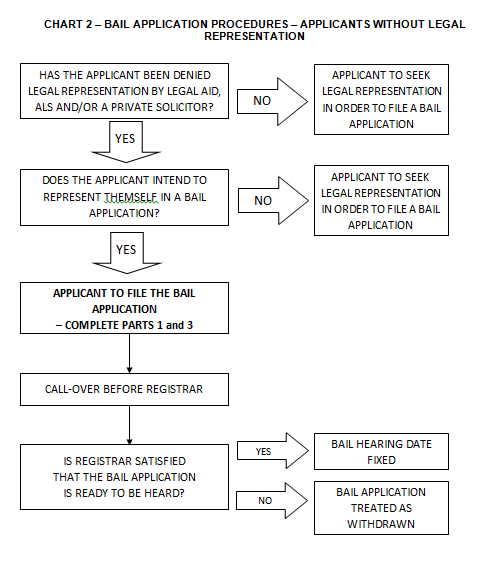1 Commencement
1.1 This Practice Note was issued on 18 December 2018 and commences on 3 June 2019.
2 Review of the Practice Note
2.1 This Practice Note will be reviewed by the Court after three months of commencement.
3 Application
3.1 This Practice Note applies to Bail Applications made under the Bail Act 2013 (NSW) to be heard in the Supreme Court of New South Wales.
4 Definitions
4.1 In this Practice Note:
4.1.1 Applicant means a person applying to the Court for a bail decision to be made; this includes that person’s legal representative.
4.1.2 Bail Application means a detention application, release application, variation application or any other application made under the Bail Act 2013 (NSW);
4.1.3 Court means the Supreme Court of New South Wales;
4.1.4 email means an email sent to the email address identified on the Court’s approved form for a Bail Application;
4.1.5 Registry means the Registry of the Court.
5 Purpose
5.1 The purpose of this Practice Note is to outline the practice and procedure to be adopted for preparing and filing a Bail Application for hearing in the Court.
5.2 The practice and procedure set out in this Practice Note aim to enable the Court, wherever possible, to list all applications within 20 days of the first call-over listing.
6 Introduction
6.1 The Court will accept a Bail Application for filing only when it is ready to be listed for hearing, and specifically when:
6.2 Clause 7 of this Practice Note sets out the steps for filing a Bail Application where the Applicant has legal representation.
6.3 Clause 8 of this Practice Note sets out the steps for filing a Bail Application where the Applicant does not have legal representation.
6.4 A flowchart representation of the principal procedures is set out in Annexure A to this Practice Note.
7 Filing a release or variation application – Applicants with legal representation
7.1 An Applicant seeking to have a Bail Application listed before the Court must file with the Registry a completed Supreme Court Bail Application form, which can be found using the following link:
www.supremecourt.justice.nsw.gov.au/Pages/sco2_formsfees/SCO2_forms/SCO2_forms_subject/crime_bail_forms.aspx
7.2 The form must be completed in full and be accompanied by all documents (as set out in the form) on which the Applicant relies in support of the Bail Application, including confirmation that the Bail Application is ready to be heard. Lodging an incomplete form may lead to the form being rejected for filing.
7.3 The Applicant must also confirm in the form that they have:
7.4 The Applicant’s legal representative must complete the form, sign it and file it with the Court; otherwise the Bail Application may be rejected for filing.
7.5 The completed Bail Application form and attachments may be lodged in the following ways for filing:
7.6 The Applicant must serve the Bail Application, including attachments, on the opposing party on the day of filing.
7.7 After the Bail Application is accepted for filing, it will be either:
7.7.1 listed for a call-over and the Registry will send the parties a Notice of Listing confirming the call-over date; or
7.7.2 at the Court’s discretion, listed by the Registrar in chambers, without a call-over, for a hearing and the Registry will send the parties a Notice of Listing confirming the hearing date and providing orders for the filing and service of submissions and any other material by the opposing party. Those materials must be filed in any of the ways listed in Clause 7.5 of this Practice Note.
7.8 Wherever practical, the Court’s aim is to list all applications within 20 days of the first call-over listing.
8 Filing a release or variation application – Applicants without legal representation
8.1 An Applicant who does not have legal representation may file a Bail Application with the Court, provided the Applicant fully completes Parts 1 and 3 of the Supreme Court Bail Application form, which can be found using the following link:
www.supremecourt.justice.nsw.gov.au/Pages/sco2_formsfees/SCO2_forms/SCO2_forms_subject/crime_bail_forms.aspx
8.2 The Applicant must confirm within that form that either:
8.2.1 they do not wish to obtain legal representation for the Bail Application and will represent themselves; or
8.2.2 they have:
8.3 The Bail Application may be filed in any of the ways listed at Clause 7.5 of this Practice Note.
8.4 The Court will reject the Bail Application for filing if the Applicant has (or is proposing to obtain) legal representation (any Bail Application must then be filed in accordance with Clause 7 of this Practice Note).
8.5 If the Court accepts the Bail Application for filing:
9 Detention applications
9.1 The Crown, when seeking to have a detention application listed before the Court, must file with the Registry a completed Supreme Court Bail Application form, which can be found using the following link:
www.supremecourt.justice.nsw.gov.au/Pages/sco2_formsfees/SCO2_forms/SCO2_forms_subject/crime_bail_forms.aspx
9.1.1 Part 1 (sections A and B) and Part 3 of the approved form must be completed in full.
9.2 The Crown must personally serve the Bail Application on the respondent and their last known legal representative (either personally, or by email or fax) on the day of filing or as soon as possible thereafter.
9.3 After the Bail Application is accepted for filing, it will be either:
9.3.1 listed for a call-over and the Registry will send the parties a Notice of Listing confirming the call-over date; or
9.3.2 at the Court’s discretion, listed by the Registrar in chambers, without a call-over, for a hearing and the Registry will send the parties a Notice of Listing confirming the hearing date and providing orders for the filing and service of submissions and any other material by both parties. Those materials must be filed in any of the ways listed in Clause 7.5 of this Practice Note.
9.4 Detention applications will be listed with expedition and counsel’s availability will not be taken into consideration unless there are exceptional circumstances.
10 Call-overs and listing for hearing
10.1 The cut-off day for Bail Applications to be listed in a call-over is the Wednesday of the week prior to the call-over.
10.2 At the call-over, if the Registrar is satisfied that a Bail Application is ready to proceed to a hearing, a hearing date will be fixed. In all other cases the Registrar will treat the Bail Application as having been withdrawn. This does not preclude an Applicant from filing a further Bail Application.
10.3 Bail Applications listed for call-over will not be adjourned to a future call-over unless there are exceptional circumstances.
10.4 Bail Applications are allocated a maximum of 30 minutes when listed for hearing. If an Applicant seeks a longer listing, an affidavit setting out reasons must be filed at the same time as the Bail Application.
10.5 When fixing a hearing date, counsel’s availability will not be taken into consideration unless there are exceptional circumstances.
10.6 After fixing a hearing date the Registrar will fix a timetable for the filing and service of submissions and any other material by the opposing party. These must be filed in any of the ways listed in Clause 7.5 of this Practice Note.
11 Adjournments
11.1 The Court will not grant an adjournment of a Bail Application unless there are exceptional circumstances.
11.2 If an Applicant seeks to adjourn a Bail Application that has been filed but has not yet been listed for hearing, the Applicant must apply to the Court by email. The application will be considered by the Registrar in chambers.
11.3 If an Applicant seeks to adjourn a Bail Application that has been listed for hearing, the Applicant must apply to the Court by email and include an affidavit setting out the reasons why the Applicant seeks the adjournment. Adjournment applications will be rejected if they are not accompanied by an affidavit setting out the reasons.
11.3.1 Hearing dates will not be vacated except by an order of the Court.
11.3.2 Adjournment applications made within two business days of the allocated hearing date will be referred to the presiding Judge for determination.
11.3.3 Adjournment applications made earlier than two business days prior to the allocated hearing date will be considered by the Registrar in chambers.
11.4 If an Applicant seeks to adjourn a Bail Application on the day of hearing, the Applicant’s legal representative (or the Applicant in person if they are self-represented) must appear before the presiding Judge to make the application and provide the Court with an affidavit setting out the reasons why the Applicant seeks the adjournment.
11.5 If an adjournment is granted, the Bail Application will be listed in the next available call-over for case management. At the call-over, if the Registrar is not satisfied that the Bail Application is ready to proceed to a hearing within a time considered reasonable by the Registrar, the Registrar will treat the Bail Application as having been withdrawn. This does not preclude an Applicant from filing a further Bail Application.
12 Withdrawing a Bail Application
12.1 If an Applicant seeks to withdraw a Bail Application prior to the day of hearing, the Applicant must notify the opposing party and the Court by email, including confirmation of notification to the opposing party. The application will then be withdrawn.
12.2 If an Applicant seeks to withdraw a Bail Application on the day of hearing, the Applicant must appear before the presiding Judge to withdraw the application.
13 Applicants released from custody or sentenced to imprisonment before bail hearing
13.1 Where the Court is advised (either by the Applicant, the Applicant’s opponent, another Court or Corrective Services NSW), prior to an allocated hearing date for a Bail Application, that an Applicant has either been released from custody or sentenced, the Court will treat the Bail Application as having been withdrawn.
T F BATHURST AC
Chief Justice of NSW
18 December 2018
Related Information:
Bail Act 2013 (NSW)
Amendment history:
18 December 2018: The Practice Note issued on 4 February 2016 and commencing on 7 March 2016 is replaced.
ANNEXURE A – BAIL APPLICATIONS TO THE SUPREME COURT
CHART 1 – BAIL APPLICATION PROCEDURES – APPLICANTS WITH LEGAL REPRESENTATION

CHART 2 – BAIL APPLICATION PROCEDURES – APPLICANTS WITHOUT LEGAL REPRESENTATION
